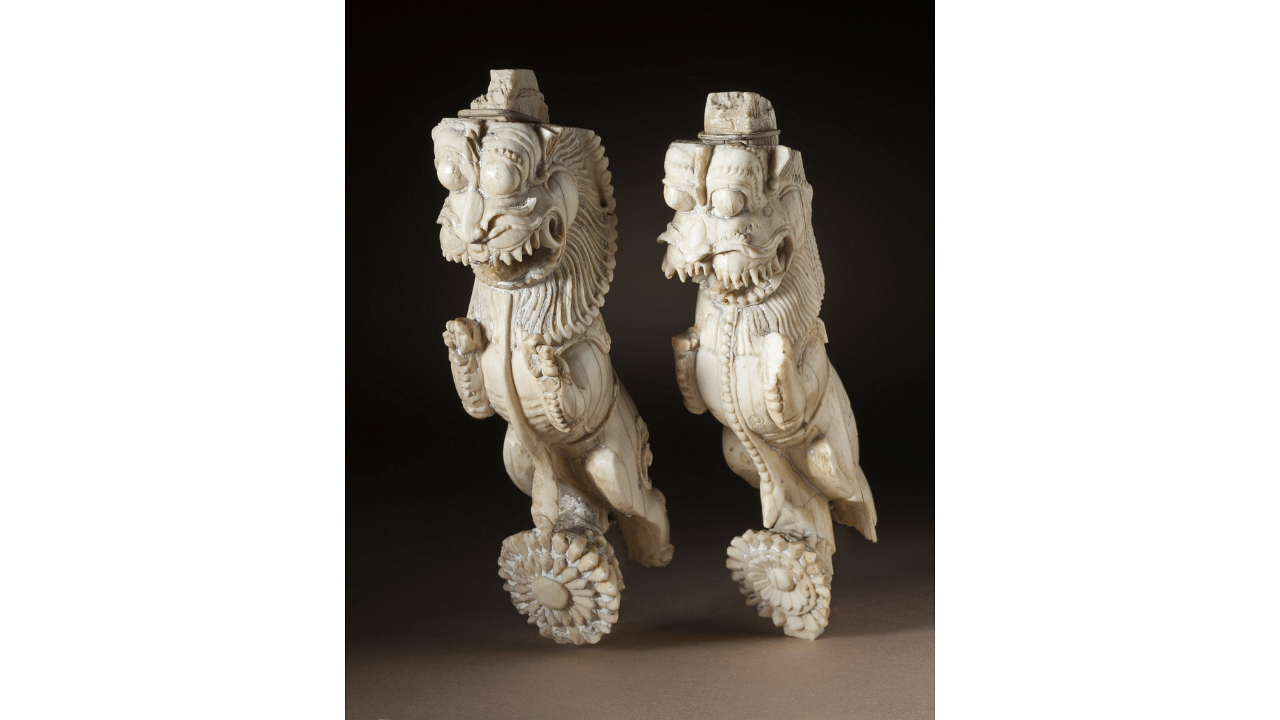
A pair of architectural brackets in the form of rampant leonine creatures (yali or vyala), from a processional mandapa, Madurai, 17th century, ivory with traces of paint.
(Pic courtesy: The Los Angeles County Museum Of Art)
Standing outside a Thai temple or an Indian stupa, one is often startled by otherworldly creatures — in the form of stone figures and murals — that decorate the doorways, entrances and walls of sacred sites. Bearing sharp fangs and mostly in grotesque forms, these fierce creatures are the guardian spirits in Buddhist, Jain and Hindu mythology. They are said to protect deities and humans from malevolent spirits and control the natural forces within their realms.
For example, yakshas and yakshis — usually benign but occasionally mischievous, sexually aggressive, and sometimes violent nature spirits — are depicted in a stately human form across early Hindu, Buddhist and Jain art. On the other hand, makaras and the many types of yali, showcase animal features and chimeric forms. Guardian spirits such as the rakhandars feature in regional or Adivasi folklore and are worshipped in the villages of Goa, while jimmidaari yaya, is worshipped by the Gond community.
The distinctively wrathful appearance of guardian spirits in South Asian art has enormous mystical significance: it allows the spirits to simultaneously embody and challenge negative, supernatural forces — whether it is demons who attack temples and homes or evil spirits who curse individuals — and repel them, warding off any potential threats against those they protect. Often, a likeness or representation of the guardian spirit is worn in talismanic pendants, around the neck and hidden under the shirt of the wearer.
Several deities are also believed to avert illnesses and diseases. Goddesses such as Mariamman and Shitala protect their devotees from smallpox. Another goddess, Ola Devi, also associated with Shitala, is worshipped by communities in northern and western India to gain protection from cholera.
Hariti, who is worshipped as an epidemic goddess, was widely depicted in Gandharan sculptures during the 2nd century CE when the region was reeling from the threat of a pandemic. In Buddhist mythology, Hariti grew from a child-devouring demoness to a goddess and is often depicted alongside Kubera — the king of yakshas and god of wealth. Kubera is also a lokapala, guardian of the north, in both Hindu and Buddhist traditions and, therefore, assumes the role of a dvarapala, or doorway guardian, in temples.
Such cross-cultural biographies of guardian spirits are present in many South Asian religious traditions. A significant number of protector deities in Tibetan Buddhism, each safeguarding specific texts, monasteries, regions or the religion in general, originate from local deities in the Indian subcontinent and the Himalayan regions. Thus, defying cultural and caste boundaries, guardian spirits acknowledge and respond to the existential hurt and fear haunting people’s psyche across South Asia.
Discover Indian Art is a monthly column that delves into fascinating stories on art from across the sub-continent, curated by the editors of the MAP Academy. Find them on Instagram as @map_academy